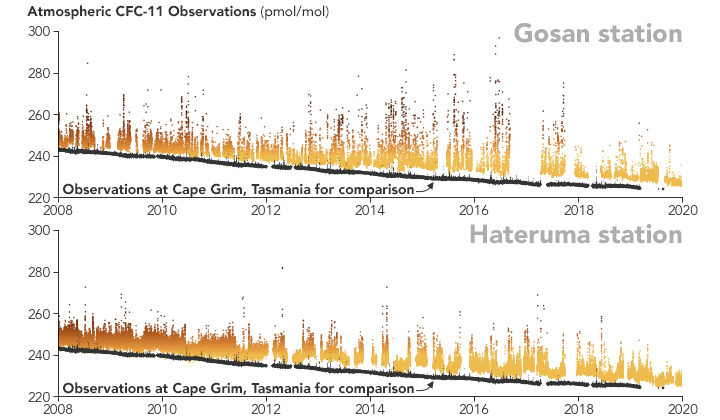

For more than 30 years, nations have been working to protect Earth’s stratospheric ozone layer by banning the new production and trade of ozone-depleting substances. Part of that effort has included tracking the atmospheric concentration of such chemicals.
In 2018, researchers noticed that after years of steady declines, the concentration of a particular ozone-depleter leveled off globally. With deeper investigation, they then uncovered a source of new emissions from eastern China. In research published in February 2021 in the journal Nature, scientists reported that the resurgence in emissions of trichlorofluoromethane (CFC-11 or freon-11) from China and other unreported sources was short-lived and should not significantly delay the recovery of Earth’s ozone layer.
Stratospheric ozone is a natural sunscreen that helps shield us from harmful ultraviolet (UV) rays from the Sun. In the 1970 and 80s, scientists discovered that chemicals widely used in refrigerants and insulating foams were rising into the stratosphere. Those chlorofluorocarbons (CFCs) are broken down by UV light into forms that cause the destruction of ozone molecules. Stratospheric ozone concentrations fell globally, and the problem became most acute over the South Pole, where an “ozone hole” started forming annually. In 1987, an international treaty was enacted to prevent additional degradation: the Montreal Protocol banned CFCs, while creating protocols to track their emissions.
Even after production ceased, scientists still expected chemicals like CFC-11 to continue leaking from existing products for years, but at a gradually declining rate. The gases are monitored by groups like the U.S. National Oceanic and Atmospheric Administration (NOAA) and the Advanced Global Atmospheric Gases Experiment (AGAGE), a network of monitoring stations funded by NASA and environmental agencies and headed by the Massachusetts Institute of Technology and the Scripps Institution of Oceanography.
In 2018, NOAA first reported that atmospheric CFC-11 had declined less than expected, hinting that something had changed. “The slow-down in the rate of decline indicated that somebody was emitting again, or in larger quantities than we were expecting, we just didn’t know where,” said Matt Rigby, a University of Bristol scientist and one of the lead authors of the new studies.

The maps at the top of this page show estimates of the emissions of CFC-11 from eastern China between 2008 and 2019 as calculated by an atmospheric transport model developed by the study authors. The plots above show the concentrations of the chemical as observed by ground-based instruments in the AGAGE network. Note the spikes in the line plot between 2013 and 2017. The Gosan station, run by South Korea’s Kyungpook National University, and the Hateruma Island station, run by Japan’s National Institute of Environmental Studies, were both positioned close enough for researchers to trace most of the new emissions back to eastern China.
“This is very much like detective work,” said Qing Liang, a co-author of the study and an atmospheric chemist at NASA’s Goddard Space Flight Center. “We figured out there was a problem, then we tracked down the problem regionally, and it seems that the actions taken in China, and perhaps elsewhere, have resulted in a big drop in the unexpected emissions.”
“This was evidence for probably the biggest challenge that the Montreal Protocol has ever faced, but I think it has been heartening to see how closely the science has been listened to by the parties of the Montreal Protocol, and then how rapidly the science has been acted on as well,” added Rigby. “All of this has happened over the space of essentially two years, which is pretty incredible.”
The scientists noted that the some of the mid-decade emissions are still unaccounted for, and scientists have been unable to pinpoint where they are coming from due to current limitations of the monitoring network. But the overall global decline in CFC-11 concentrations has resumed.
“The findings are very welcome news and hopefully mark an end to a disturbing period of apparent regulatory breaches,” said Luke Western, a co-lead author of one of the studies and an atmospheric scientist at the University of Bristol. “If the emissions had stayed at the significantly elevated levels we found, there could have been a delay, possibly of many years, in ozone layer recovery. On top of that, since CFC-11 is also a potent greenhouse gas, the new emissions were contributing to climate change at levels similar to the carbon dioxide emissions of a megacity.”
NASA Earth Observatory images by Joshua Stevens, using data courtesy of Park, S. et al. (2021). Story by Lara Streiff, NASA Earth Science News Team, with Mike Carlowicz.